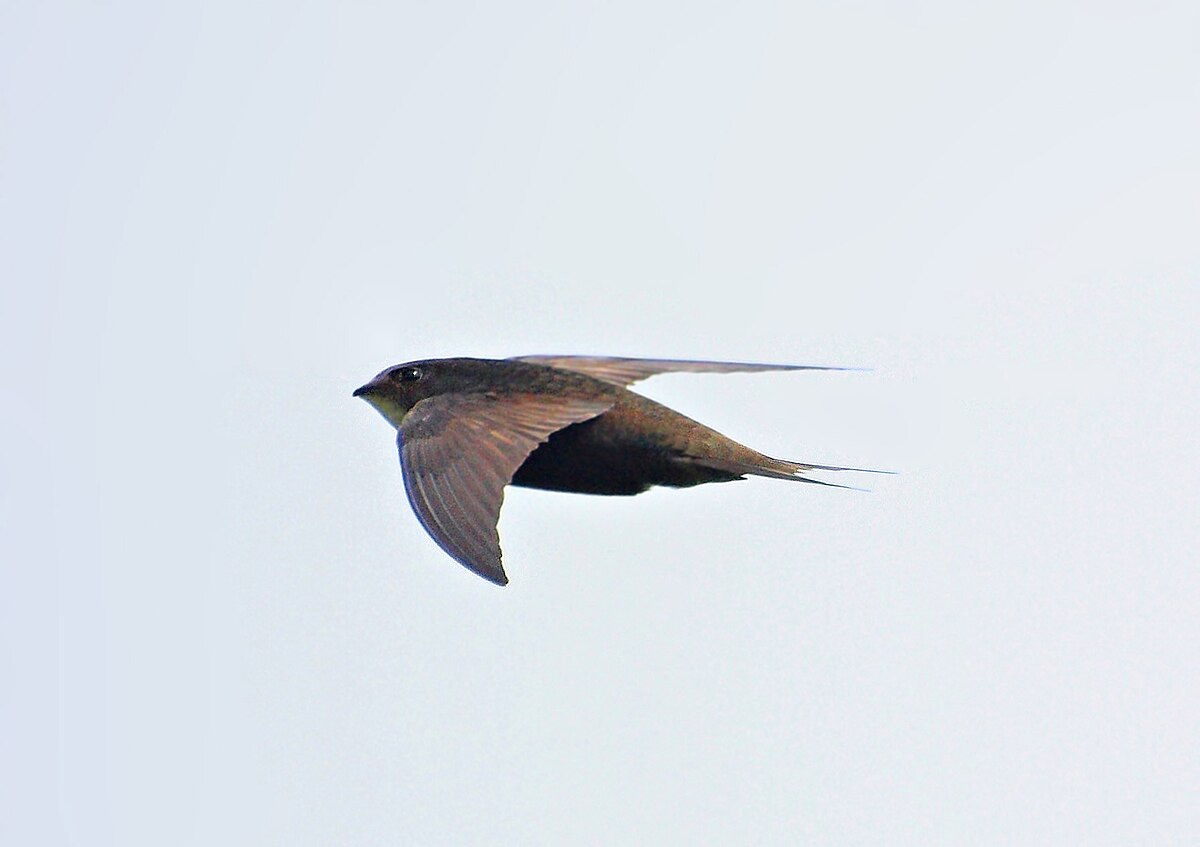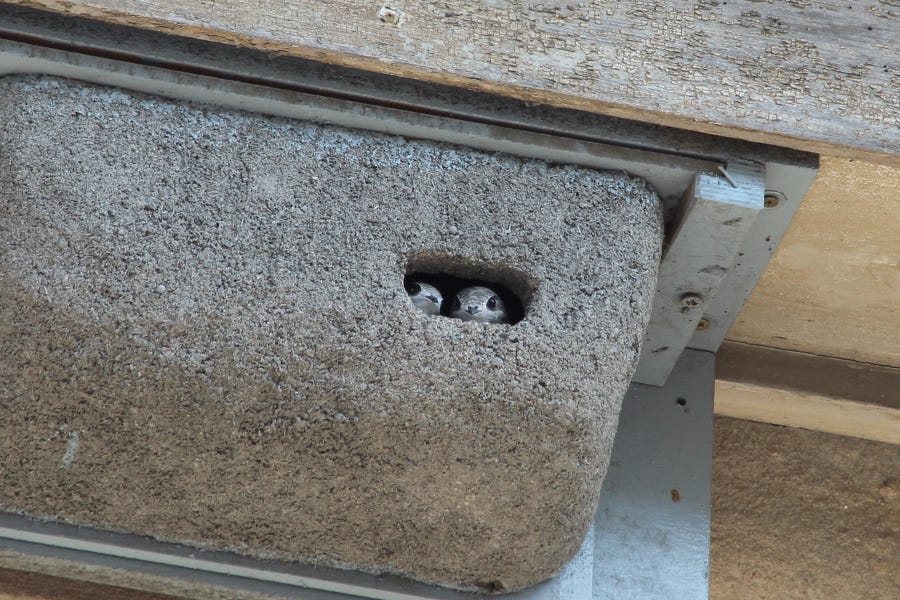Soaring for Survival: Unveiling Swifts
Imogen celebrates the humble swift during Swift Awareness Week
Ever just sat there and marvelled at the life of swifts? I have. I remember seeing them streaming from a cave entrance at dusk in South East Asia, heading out to hunt those insects on the wing, swooping and diving and screaming. Mistaken for bats at first, they were just there in amongst the black plume of of biomass engulfing the skies. Their nests are a delicacy for soup making in those parts of the world, and their presence intertwined with the local culture.
Back in Blighty, our common swifts nests are less of an edible feast, but no less of a marvel. The nests themselves are constructed from various materials gathered in flight, such as feathers, grass, and other small debris, all bound together with the bird's saliva. The birds themselves visit us for a mere 12 weeks or so each year to raise their broods.
Swifts feed on small flying insects, capturing them mid-flight. These insects accumulate in a specialised pouch located at the back of the swift's throat, where they are bound together by saliva, forming a pellet or bolus. This bolus can be regurgitated and fed to their chicks. A single bolus can contain as many as 1,000 insects, which equates to a substantial number of midges!
Swifts are unique in their nesting choices. Unlike many birds that prefer trees or ground-level locations, swifts predominantly nest in cavities. In urban areas, they favour old buildings, using crevices, eaves, and holes to establish their nests. They exhibit strong site fidelity, often returning to the same nesting site year after year to raise their young. This behaviour means we need to preserve their nesting habitats and educate others as to why they cannot be relocated easily.
Swift Awareness Week
Swifts, along with their relatives, swallows and house martins, are some of the most captivating birds to grace our skies. Their remarkable aerial prowess, long migratory journeys, and unique nesting habits make them a focal point for bird lovers across the UK and beyond.
Each year, nature enthusiasts and conservationists come together for the RSPB's Swift Awareness Week, a crucial initiative aimed at raising awareness and promoting efforts to protect these remarkable birds. Swift Awareness Week events are organised by various independent local groups within the Swifts Local Network, as well as by RSPB local groups and RSPB nature reserves.
Common swifts (Apus apus) are renowned for their extraordinary flight capabilities. Spending almost their entire lives on the wing, they eat, sleep, and even mate in the air. Swifts are easily recognisable by their scythe-like wings and rapid, screaming sound and flight patterns, often seen darting through urban landscapes during the summer months. They can fly up to 70mph! Imagine!
Migratory Routes and Overwintering
The migratory journey of swifts is a marvel of nature. Each year, swifts travel from their breeding grounds in the UK to wintering sites in sub-Saharan Africa. This migration covers thousands of miles, with swifts typically departing the UK in late July and returning by late April or early May.
Their journey is not a direct one. Swifts follow a route that takes them through various countries in Europe and across the Mediterranean Sea. From there, they traverse the Sahara Desert, continuing down to Central and Southern Africa. Specific overwintering sites are spread across countries like Congo, Gabon, and parts of East Africa, where they find the insects they need to survive the winter months.
For those with an interested in the evolution of long distance migration patterns, I stumbled across this interesting paper on the subject:
Aerial Cousins
Let’s not us forget the swallows and house martins, who are close relatives of swifts, sharing similar migratory patterns and aerial lifestyles.
Swallows (Hirundo rustica) are known for their long, forked tails and fluid flight. They often nest in barns and under eaves, creating mud nests lined with feathers.
House Martins (Delichon urbicum) have a distinctive white rump and build nests from mud pellets under the eaves of buildings. Like swifts, they are excellent flyers and spend much of their time in the air catching insects.

Both swallows and house martins also migrate to sub-Saharan Africa for the winter, making incredible journeys similar to those of swifts.
Swifts, Swallows and House Martins are currently experiencing a dramatic 40% decline in population according to the citizen science project the Breeding Bird Survey, which raises serious concerns about their future.
The primary factors contributing to this decline include:
Loss of Nesting Sites: Modern building practices often eliminate the cavities these birds rely on for nesting.
Insect Declines: Less flying insects - mean less food!
Habitat Destruction: The destruction of habitats along migratory routes and in wintering grounds impact populations.
Due to these threats, swifts are classified as Red on the UK's Birds of Conservation Concern list, indicating that they are a high conservation priority.
How Can We Help Swifts?
If you would like to help swifts and learn more about these remarkable birds Huntley and District Swift Group is the nearest group for the north of scotland.
There are a couple of events taking place this week:
Wednesday 3 July: Huntly, Aberdeenshire.
A Swift Walk and Talk by Huntly Swifts between 8–9.30 pm. Meet outside Orbs Bookshop. Booking essential: huntlySwiftgroup@gmail.com or 07411 808 573. Free, but a £5 donation is welcome.
Sunday 7 July: National Trust for Scotland Fyvie Castle
Turriff, Aberdeenshire AB53 8JS. 10.30 - 3.30pm. Fyvie Swift Day: stall and swift watching organised by Huntly Swift Group. For more info call 07411 808 573 Free/no booking required.
Conservation efforts can significantly impact swift populations. There was some work undertaken in 2006 in Highland and the rest of Scotland to provide nesting sites.
Ways you can help:
1. Install Nest Boxes: Providing specially designed swift nest boxes on buildings can create new nesting opportunities. These boxes can be placed under eaves or high on walls, mimicking their natural nesting preferences.
2. Protect Existing Nest Sites: When renovating old buildings, it is crucial to consider the presence of swifts and ensure their nesting sites are preserved or replaced.
3. Support Insect Populations: Reducing pesticide use and reducing mowing to promote insect-friendly gardens, can make a big difference and maintain the abundance of insects that swifts feed on.
4.Participate in Citizen Science: Engaging in monitoring programs and reporting swift sightings can contribute valuable data to conservation organisations.
Swifts are incredible birds that enrich our enjoyment of the natural world with their presence and astonishing aerial displays. By understanding their nesting habits, migratory routes, and the challenges they face, we can take meaningful steps to protect and support swift, swallow and house martin populations. Through collective efforts in conservation and awareness, particularly during events like the RSPB's Swift Awareness Week, we can ensure that future generations continue to enjoy the sight of swifts and their kin - soaring in our skies.
Imogen Furlong, the High Life Highland Countryside Ranger Manager, is known for her enthusiasm, organisation, and drive. Her deep passion for the Scottish Highlands' wildlife and extensive experience in outdoor education and recreation management have been central to this role. Imogen is a practical and collaborative project manager, empowering her teams to work effectively in communities and contribute to local conservation efforts.









I love swifts and enjoy watching them in my local area where a few of them nest. I enjoyed your article, but swifts aren't closely related to swallows and house martins! It's a case of convergent evolution - https://en.wikipedia.org/wiki/Swift_(bird)